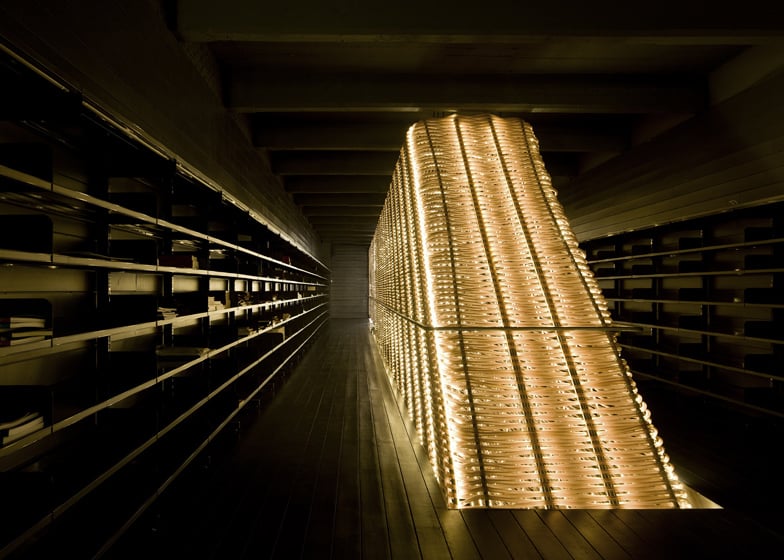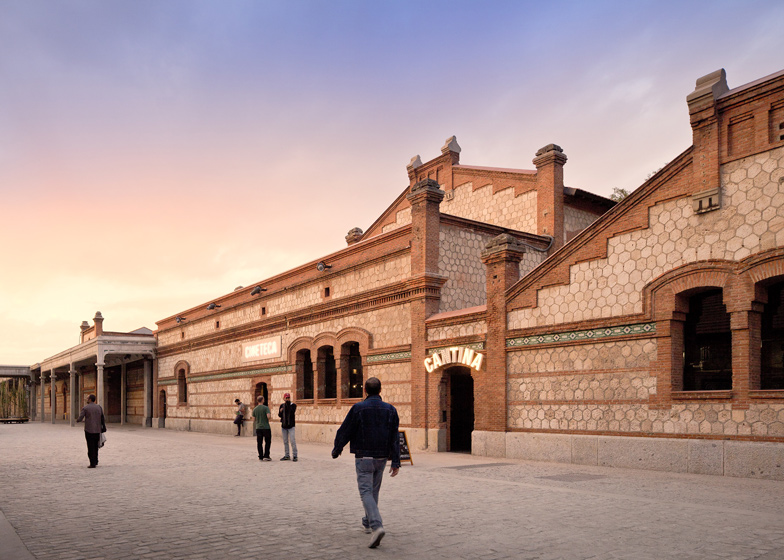Slideshow: Huge glowing baskets surround the staircases of this former slaughterhouse in Madrid that Spanish architects Churtichaga + Quadra-Salcedo have converted into a cinema.
First constructed at the start of the twentieth century, the Cineteca Matadero was used as an abattoir and livestock market for around 85 years, but is now renovated to accomodate two cinema screens, a film studio, an archive and a terrace for outdoor screenings.
The illuminated orange structures dominate the three floors of the film archive, which are otherwise dimly lit and lined with dark grey-painted wood.
Woven walls also surround the two auditoriums but are painted black so as not to detract from the screens.
In the studio areas, the existing brick walls of the hundred-year-old building are mostly left exposed, although some are partially covered with wooden panels.
We've published a few unusual conversion projects from Spain recently. See our earlier stories about a market hall converted into a children’s centre and a civic centre inside a former prison.
Photography is by Fernando Guerra.
Here's a bit more information from Churtichaga + Quadra-Salcedo:
Cinema Center in Matadero de Legazpi, Madrid
Refurbishment and conversion of an old slaughterhouse into a public cinema center housing a film archive, film and television studio, two cinemas, offices, canteen, and summer film patio.
Memory, memories, even bad memory always twist and fly when we work on architectural past, … yes, make a story, choose the tone, cadence, rhythm, accents, a story that naturally coexist with collective memory of the old slaughterhouse of Madrid, with another early report of new application dedicated to the movies while curled up with the forgetfulness of their own recurrent obsessions…
The magical backlight and contrast of the films, and the childhood fascination of basketry and technical human infinite geometries are the sensory triangle… the rest is to surround in spiral this atmosphere, this feeling, and define it constructively.
The tectonic history of brickland, the powerful rhetoric of the old slaughterhouse is the background, and also figure at the scenes of the story, a story in which a continuous low background, a wooden monomaterial painted in dark gray defines the new program deployed on walls, floors and ceilings, allowing a clear separation between story and History.
Against this dark carpet background, my own memory outputs a floating figures, some huge vibrant baskets that define the main spaces.
The Film Archive Area is covered by a permeable basket, huge, walkable, that filters light and works as a lamp, a huge figure of a modest orange hose knitted infinitely.
The Baskets that define Film rooms are shades of black. In the main room the orange background illuminated make the basket float until the movie begins, the background disappears and only a vibrant black surface stays.
In the small projection room, a basket-banked trough very black on black space fleet almost black wood, only when you open a window dazzles the eye.
Because the eye and limits of perception are ultimately the real protagonists of this history of cinema.
Silent Structure:
There is a constructive and structural battle, a battle to defend silent and hidden history. And to defend it is to disobey the pathology reports that distrust of the History of the factory building, do not understand that the factories of brick and masonry love to be charged… are happier and more cohesive… and that its logic is always a problem of stability and strength.
Relying on these unrepeatable walls of solid brick and lime mortar, the intervention has solved the great spam required by the program. The horizontal structure has been solved with reinforced concrete slabs, whose two-way working with the existing brick walls make a complete set of vertical load-bearing walls, distributing efforts through the generous cloth walls.
The foundations of these walls was reinforced overloading batteries slightly inclined of micropiles penetrating under the vertical projection of stepped masonry foundations.
Background and Baskets:
Upon resolution of the structure, a continuous carpet of grey painted pine flooring covers walls, floors and ceilings defining the new architecture of space.
Against this dark wood background, the monomaterial woven baskets, frames made of bent steel tubing as the guarantors of geometry, and woven with conventional industrial irrigation hoses.
Facilities:
The spaces defined by the tectonics of the preexisting, the dark background of wood and the protagonists of the baskets figures required a deliberate silence on the introduction of the facilities.
The enormous demand of fresh air that require the Plato and the Cinemas need a huge conducts that gets buried under ground most of these easements. The areas without such large ventilation requirements, such as lobbies, offices and circulation areas are solved with underfloor heating / cooling systems.
The lighting is deliberately disordered avoiding the perverse and sad homogeneity to which we are pushed by our regulations. Clusters of bulbs view dances in the walls… stripes of woven LEDs lighten the baskets and the space underneath.
Project name: Cinema Center in Matadero de Legazpi
Location: Matadero de Legazpi, Madrid, Spain
Program: Refurbishment and conversion of an old slaughterhouse into a public cinema center housing a film archive, film and television studio, two cinemas, offices, canteen, and summer film patio
Area: Built-up Area: 2.688 m2
Year: Design: 2009 • Completion: 2011
Cost: 4.104.843 €
Client: Madrid City Council
Project by: churtichaga+quadra salcedo architects
Team: Principal Designer: Josemaria de Churtichaga • Project Design Team: Mauro Doncel Marchán, Natanael López Pérez • Building Design Team: Leticia López de Santiago
Others: Contractor: Edhinor • Quantity Surveyor: Joaquín Riveiro Pita, Martín Bilbao Bergantiños • Structural Surveyor: Euteca • Facilities Surveyor: Úrculo Ingenieros Consultores














